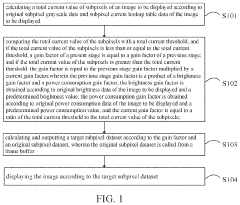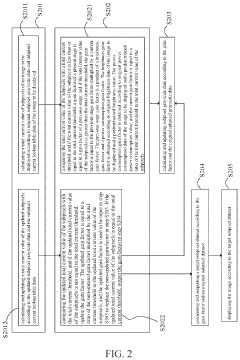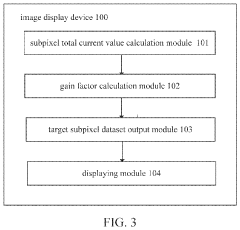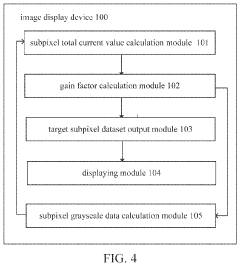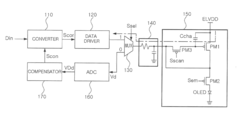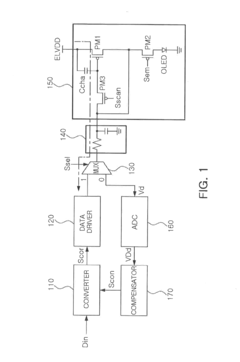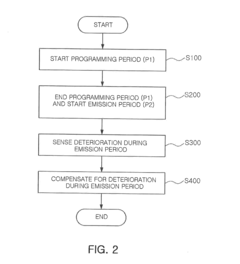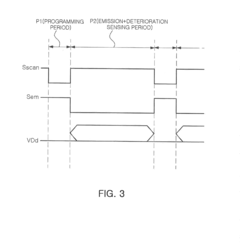Utilizing AI for efficient AMOLED power management.
JUL 17, 20258 MIN READ
Generate Your Research Report Instantly with AI Agent
Patsnap Eureka helps you evaluate technical feasibility & market potential.
AI-AMOLED Power Optimization Background
The integration of Artificial Intelligence (AI) with Active-Matrix Organic Light-Emitting Diode (AMOLED) technology represents a significant advancement in display technology and power management. AMOLED displays have gained popularity due to their superior image quality, flexibility, and energy efficiency compared to traditional LCD screens. However, as mobile devices and other AMOLED-equipped gadgets become more sophisticated, the demand for efficient power management has intensified.
AI-driven power optimization for AMOLED displays emerges as a promising solution to address these challenges. This approach leverages machine learning algorithms and neural networks to analyze usage patterns, environmental conditions, and content characteristics in real-time. By doing so, it can dynamically adjust display parameters to achieve optimal power consumption without compromising visual quality.
The evolution of this technology can be traced back to the early 2010s when researchers began exploring the potential of AI in display technology. Initial efforts focused on basic brightness adjustment based on ambient light sensors. As AI capabilities advanced, more complex algorithms were developed to consider factors such as user preferences, application usage, and even the emotional impact of displayed content.
One of the key drivers behind this technological convergence is the increasing prevalence of edge computing in mobile devices. This allows for more sophisticated AI models to run directly on the device, enabling real-time decision-making without relying on cloud processing. This local processing not only enhances privacy but also reduces latency in power management adjustments.
The market demand for AI-powered AMOLED optimization is fueled by several factors. Consumers are increasingly seeking devices with longer battery life without sacrificing display quality. Additionally, the growing awareness of energy conservation and sustainability has put pressure on manufacturers to develop more eco-friendly solutions. The rise of 5G technology and augmented reality applications has further intensified the need for efficient power management in high-performance displays.
As we look towards the future, the integration of AI and AMOLED technology is expected to play a crucial role in the development of next-generation mobile devices, wearables, and automotive displays. The potential benefits extend beyond power savings to include enhanced user experience, improved device longevity, and even personalized visual experiences tailored to individual users' preferences and needs.
AI-driven power optimization for AMOLED displays emerges as a promising solution to address these challenges. This approach leverages machine learning algorithms and neural networks to analyze usage patterns, environmental conditions, and content characteristics in real-time. By doing so, it can dynamically adjust display parameters to achieve optimal power consumption without compromising visual quality.
The evolution of this technology can be traced back to the early 2010s when researchers began exploring the potential of AI in display technology. Initial efforts focused on basic brightness adjustment based on ambient light sensors. As AI capabilities advanced, more complex algorithms were developed to consider factors such as user preferences, application usage, and even the emotional impact of displayed content.
One of the key drivers behind this technological convergence is the increasing prevalence of edge computing in mobile devices. This allows for more sophisticated AI models to run directly on the device, enabling real-time decision-making without relying on cloud processing. This local processing not only enhances privacy but also reduces latency in power management adjustments.
The market demand for AI-powered AMOLED optimization is fueled by several factors. Consumers are increasingly seeking devices with longer battery life without sacrificing display quality. Additionally, the growing awareness of energy conservation and sustainability has put pressure on manufacturers to develop more eco-friendly solutions. The rise of 5G technology and augmented reality applications has further intensified the need for efficient power management in high-performance displays.
As we look towards the future, the integration of AI and AMOLED technology is expected to play a crucial role in the development of next-generation mobile devices, wearables, and automotive displays. The potential benefits extend beyond power savings to include enhanced user experience, improved device longevity, and even personalized visual experiences tailored to individual users' preferences and needs.
Market Demand Analysis
The market demand for AI-powered AMOLED power management solutions is experiencing significant growth, driven by the increasing adoption of AMOLED displays in various electronic devices. As consumers seek longer battery life and improved energy efficiency in their smartphones, tablets, and wearables, manufacturers are turning to advanced power management techniques to meet these demands.
The global AMOLED display market is projected to expand rapidly, with a compound annual growth rate (CAGR) exceeding 20% over the next five years. This growth is primarily fueled by the rising popularity of AMOLED technology in high-end smartphones and the emergence of foldable devices. As AMOLED displays become more prevalent, the need for efficient power management solutions becomes increasingly critical.
AI-driven power management systems offer several advantages over traditional methods, including dynamic adjustment of display brightness, selective pixel dimming, and intelligent power allocation based on user behavior and content. These features not only extend battery life but also enhance the overall user experience by optimizing display performance.
The automotive industry is emerging as a significant market for AMOLED displays, with a growing number of electric vehicles incorporating large, energy-efficient screens in their interiors. This trend is creating new opportunities for AI-powered AMOLED power management solutions tailored to the unique requirements of automotive applications.
Consumer electronics manufacturers are increasingly prioritizing energy efficiency as a key differentiator in their product offerings. This focus on sustainability and extended battery life is driving demand for innovative power management technologies that can maximize the energy efficiency of AMOLED displays without compromising visual quality.
The integration of AI in AMOLED power management aligns with the broader trend of edge AI, where machine learning algorithms are deployed directly on devices. This approach reduces latency and enhances privacy, making it particularly attractive for smartphone manufacturers and other OEMs seeking to differentiate their products in a competitive market.
As 5G networks continue to roll out globally, the demand for power-efficient displays is expected to intensify. The increased data consumption and processing requirements of 5G-enabled devices will place additional strain on battery life, further emphasizing the need for advanced power management solutions that can intelligently optimize display energy consumption.
In conclusion, the market for AI-powered AMOLED power management solutions is poised for substantial growth, driven by consumer demand for longer-lasting devices, the expansion of AMOLED technology into new sectors, and the ongoing push for energy efficiency in electronic products. As the technology matures and demonstrates its value in real-world applications, it is likely to become a standard feature in a wide range of AMOLED-equipped devices across multiple industries.
The global AMOLED display market is projected to expand rapidly, with a compound annual growth rate (CAGR) exceeding 20% over the next five years. This growth is primarily fueled by the rising popularity of AMOLED technology in high-end smartphones and the emergence of foldable devices. As AMOLED displays become more prevalent, the need for efficient power management solutions becomes increasingly critical.
AI-driven power management systems offer several advantages over traditional methods, including dynamic adjustment of display brightness, selective pixel dimming, and intelligent power allocation based on user behavior and content. These features not only extend battery life but also enhance the overall user experience by optimizing display performance.
The automotive industry is emerging as a significant market for AMOLED displays, with a growing number of electric vehicles incorporating large, energy-efficient screens in their interiors. This trend is creating new opportunities for AI-powered AMOLED power management solutions tailored to the unique requirements of automotive applications.
Consumer electronics manufacturers are increasingly prioritizing energy efficiency as a key differentiator in their product offerings. This focus on sustainability and extended battery life is driving demand for innovative power management technologies that can maximize the energy efficiency of AMOLED displays without compromising visual quality.
The integration of AI in AMOLED power management aligns with the broader trend of edge AI, where machine learning algorithms are deployed directly on devices. This approach reduces latency and enhances privacy, making it particularly attractive for smartphone manufacturers and other OEMs seeking to differentiate their products in a competitive market.
As 5G networks continue to roll out globally, the demand for power-efficient displays is expected to intensify. The increased data consumption and processing requirements of 5G-enabled devices will place additional strain on battery life, further emphasizing the need for advanced power management solutions that can intelligently optimize display energy consumption.
In conclusion, the market for AI-powered AMOLED power management solutions is poised for substantial growth, driven by consumer demand for longer-lasting devices, the expansion of AMOLED technology into new sectors, and the ongoing push for energy efficiency in electronic products. As the technology matures and demonstrates its value in real-world applications, it is likely to become a standard feature in a wide range of AMOLED-equipped devices across multiple industries.
Current Challenges in AMOLED Power Management
AMOLED displays have become increasingly popular in mobile devices due to their superior image quality and energy efficiency. However, as these displays become more advanced and integrated into a wider range of devices, power management remains a critical challenge. One of the primary issues is the non-linear power consumption of AMOLED displays, which varies significantly depending on the content being displayed.
The dynamic nature of AMOLED power consumption makes it difficult to implement traditional power management techniques effectively. Unlike LCD displays, where backlight dimming can uniformly reduce power consumption, AMOLED displays require pixel-level power management. This complexity is further compounded by the fact that different colors consume varying amounts of power, with blue pixels typically being the most energy-intensive.
Another significant challenge is balancing power efficiency with display quality. Aggressive power-saving measures can lead to a noticeable degradation in image quality, potentially impacting user experience. This trade-off becomes even more pronounced in high-resolution displays, where the power demands are inherently higher.
The increasing adoption of high refresh rate displays (90Hz, 120Hz, and beyond) in mobile devices presents an additional power management challenge. While these higher refresh rates offer smoother visuals, they also significantly increase power consumption, necessitating more sophisticated power management strategies.
Thermal management is another critical concern in AMOLED power management. As displays become brighter and more power-intensive, heat generation becomes a significant issue. Excessive heat can not only impact device performance but also accelerate the aging of AMOLED pixels, potentially leading to burn-in and reduced display lifespan.
The integration of advanced features such as always-on displays and under-display sensors further complicates power management. These features require careful optimization to minimize their impact on battery life while maintaining functionality.
Lastly, the variability in user behavior and environmental conditions adds another layer of complexity to AMOLED power management. Factors such as ambient light, user preferences for brightness and color settings, and varying usage patterns across different applications all contribute to the challenge of implementing effective power management solutions.
The dynamic nature of AMOLED power consumption makes it difficult to implement traditional power management techniques effectively. Unlike LCD displays, where backlight dimming can uniformly reduce power consumption, AMOLED displays require pixel-level power management. This complexity is further compounded by the fact that different colors consume varying amounts of power, with blue pixels typically being the most energy-intensive.
Another significant challenge is balancing power efficiency with display quality. Aggressive power-saving measures can lead to a noticeable degradation in image quality, potentially impacting user experience. This trade-off becomes even more pronounced in high-resolution displays, where the power demands are inherently higher.
The increasing adoption of high refresh rate displays (90Hz, 120Hz, and beyond) in mobile devices presents an additional power management challenge. While these higher refresh rates offer smoother visuals, they also significantly increase power consumption, necessitating more sophisticated power management strategies.
Thermal management is another critical concern in AMOLED power management. As displays become brighter and more power-intensive, heat generation becomes a significant issue. Excessive heat can not only impact device performance but also accelerate the aging of AMOLED pixels, potentially leading to burn-in and reduced display lifespan.
The integration of advanced features such as always-on displays and under-display sensors further complicates power management. These features require careful optimization to minimize their impact on battery life while maintaining functionality.
Lastly, the variability in user behavior and environmental conditions adds another layer of complexity to AMOLED power management. Factors such as ambient light, user preferences for brightness and color settings, and varying usage patterns across different applications all contribute to the challenge of implementing effective power management solutions.
Existing AI Solutions for AMOLED Efficiency
01 AI-driven power management for AMOLED displays
Artificial intelligence techniques are employed to optimize power consumption in AMOLED displays. These AI algorithms analyze usage patterns, content, and environmental factors to dynamically adjust display parameters, resulting in improved power efficiency without compromising visual quality.- AI-driven power management for AMOLED displays: Artificial intelligence techniques are employed to optimize power consumption in AMOLED displays. These AI algorithms analyze usage patterns, content, and environmental factors to dynamically adjust display parameters, resulting in improved power efficiency without compromising visual quality.
- Adaptive brightness control for power efficiency: Implementing adaptive brightness control mechanisms that automatically adjust the display brightness based on ambient light conditions and user preferences. This approach helps reduce power consumption while maintaining optimal visibility and user comfort.
- Pixel-level power management techniques: Developing advanced pixel-level power management strategies that selectively control individual pixels or groups of pixels. This approach allows for fine-grained power optimization by adjusting the intensity and duration of pixel illumination based on displayed content.
- Energy-efficient color management algorithms: Implementing sophisticated color management algorithms that optimize the power consumption of AMOLED displays by intelligently adjusting color gamut, saturation, and contrast. These algorithms aim to maintain visual quality while minimizing energy usage for different types of content.
- Power-aware display refresh rate optimization: Developing techniques to dynamically adjust the display refresh rate based on content type and user interaction. This approach reduces power consumption during static content display or low-motion scenarios while maintaining smooth performance for high-motion content.
02 Adaptive brightness control for power efficiency
Intelligent systems are developed to automatically adjust AMOLED display brightness based on ambient light conditions and user preferences. This adaptive control helps reduce power consumption while maintaining optimal visibility, enhancing overall device battery life.Expand Specific Solutions03 Pixel-level power management techniques
Advanced algorithms are implemented to manage power consumption at the individual pixel level in AMOLED displays. These techniques selectively activate or deactivate pixels based on displayed content, significantly reducing overall power usage, especially for dark or partially lit scenes.Expand Specific Solutions04 Machine learning for display power optimization
Machine learning models are trained to predict and optimize power consumption in AMOLED displays. These models analyze various factors such as user behavior, application usage, and display content to make real-time adjustments, maximizing power efficiency across different scenarios.Expand Specific Solutions05 Energy-efficient color management for AMOLED
Innovative color management techniques are developed to optimize power consumption in AMOLED displays. These methods involve intelligent color mapping, gamut adjustment, and selective color enhancement to achieve desired visual quality while minimizing energy usage for different types of content.Expand Specific Solutions
Key Players in AI-AMOLED Technology
The AI-powered AMOLED power management market is in a growth phase, driven by increasing demand for energy-efficient displays in smartphones and other devices. The market size is expanding rapidly, with major players like Samsung Electronics, BOE Technology, and LG Display leading the competition. These companies are investing heavily in R&D to improve AMOLED technology and power management solutions. The technology is maturing, with advancements in AI algorithms and hardware integration enhancing power efficiency. Emerging players like Himax Technologies and Applied Materials are also contributing to innovation in this space, focusing on specialized components and manufacturing processes to further optimize AMOLED power consumption.
Samsung Electronics Co., Ltd.
Technical Solution: Samsung has developed an AI-powered AMOLED power management system that utilizes machine learning algorithms to optimize pixel brightness and color intensity based on content and ambient light conditions. The system employs a neural network trained on diverse image datasets to predict optimal power settings for each pixel in real-time[1]. This approach allows for dynamic power allocation, reducing overall energy consumption while maintaining image quality. Samsung's technology also incorporates adaptive refresh rate management, automatically adjusting the display's refresh rate based on the content being displayed, further enhancing power efficiency[2].
Strengths: Industry-leading AMOLED expertise, extensive R&D resources, and integration with their own device ecosystem. Weaknesses: Potential high computational requirements for real-time AI processing on mobile devices.
Google LLC
Technical Solution: Google has developed an AI-driven AMOLED power management system as part of its efforts to optimize Android devices. Their approach utilizes federated learning to improve power efficiency across a wide range of devices without compromising user privacy[7]. The system employs on-device machine learning models that adapt to individual usage patterns and device characteristics. Google's technology also integrates with the Android operating system to provide system-level optimizations, such as intelligent app throttling and background process management, which complement the display-specific power-saving features[8].
Strengths: Deep integration with Android OS, access to diverse device data for model training. Weaknesses: Reliance on device manufacturers for hardware-level implementation.
Core AI Innovations for Power Optimization
Method of displaying image and image display device
PatentActiveUS20210280124A1
Innovation
- A method that calculates a total current value of subpixels based on original grayscale data and a lookup table, compares it to a threshold, and adjusts a gain factor to optimize the subpixel dataset for reduced power consumption while maintaining high brightness, involving steps to calculate, update, and output a target subpixel dataset for display.
Active matrix organic light emitting diode display
PatentInactiveUS20120044235A1
Innovation
- An active matrix organic light-emitting diode display that includes a data driver generating correction signals, a selector for programming and deterioration detection paths, a pixel unit with MOS transistors and a charging capacitor, and an analog-to-digital converter to detect deterioration voltage during the emission period, enabling rapid sensing and compensation of deterioration.
Energy Efficiency Regulations
Energy efficiency regulations play a crucial role in shaping the development and implementation of AI-driven AMOLED power management systems. These regulations, established by various governmental and international bodies, set standards for energy consumption in electronic devices, including smartphones and other AMOLED display-equipped products.
The European Union's Ecodesign Directive, for instance, mandates energy efficiency requirements for a wide range of products, including electronic displays. This directive has led to the development of specific regulations for displays, which indirectly influence AMOLED power management strategies. Manufacturers must ensure their devices meet these standards, driving the need for more sophisticated AI-based power optimization techniques.
In the United States, the ENERGY STAR program provides voluntary certification for energy-efficient products. While not mandatory, ENERGY STAR certification has become a de facto standard in many markets, encouraging manufacturers to invest in advanced power management technologies, including AI-driven solutions for AMOLED displays.
China's Energy Efficiency Label system, implemented by the National Development and Reform Commission, sets mandatory energy efficiency standards for various electronic products. This system has spurred innovation in power management technologies, particularly in the mobile device sector where AMOLED displays are increasingly common.
The International Electrotechnical Commission (IEC) has developed standards such as IEC 62087, which provides methods for measuring the power consumption of audio, video, and related equipment. These standards serve as benchmarks for evaluating the effectiveness of AI-driven power management systems in AMOLED displays.
As regulations evolve, they are increasingly focusing on the overall energy efficiency of devices rather than just individual components. This holistic approach encourages the development of integrated AI solutions that can optimize power consumption across all aspects of a device, including the AMOLED display.
The impact of these regulations extends beyond mere compliance. They drive innovation in AI algorithms for power management, pushing researchers and developers to create more sophisticated predictive models and adaptive control systems. This regulatory pressure has led to significant advancements in areas such as dynamic refresh rate adjustment, pixel-level brightness control, and content-aware power optimization for AMOLED displays.
Furthermore, energy efficiency regulations have fostered collaboration between display manufacturers, chip designers, and software developers. This cross-industry cooperation has resulted in more tightly integrated hardware-software solutions for AI-driven power management in AMOLED devices, ultimately benefiting consumers through improved battery life and device performance.
The European Union's Ecodesign Directive, for instance, mandates energy efficiency requirements for a wide range of products, including electronic displays. This directive has led to the development of specific regulations for displays, which indirectly influence AMOLED power management strategies. Manufacturers must ensure their devices meet these standards, driving the need for more sophisticated AI-based power optimization techniques.
In the United States, the ENERGY STAR program provides voluntary certification for energy-efficient products. While not mandatory, ENERGY STAR certification has become a de facto standard in many markets, encouraging manufacturers to invest in advanced power management technologies, including AI-driven solutions for AMOLED displays.
China's Energy Efficiency Label system, implemented by the National Development and Reform Commission, sets mandatory energy efficiency standards for various electronic products. This system has spurred innovation in power management technologies, particularly in the mobile device sector where AMOLED displays are increasingly common.
The International Electrotechnical Commission (IEC) has developed standards such as IEC 62087, which provides methods for measuring the power consumption of audio, video, and related equipment. These standards serve as benchmarks for evaluating the effectiveness of AI-driven power management systems in AMOLED displays.
As regulations evolve, they are increasingly focusing on the overall energy efficiency of devices rather than just individual components. This holistic approach encourages the development of integrated AI solutions that can optimize power consumption across all aspects of a device, including the AMOLED display.
The impact of these regulations extends beyond mere compliance. They drive innovation in AI algorithms for power management, pushing researchers and developers to create more sophisticated predictive models and adaptive control systems. This regulatory pressure has led to significant advancements in areas such as dynamic refresh rate adjustment, pixel-level brightness control, and content-aware power optimization for AMOLED displays.
Furthermore, energy efficiency regulations have fostered collaboration between display manufacturers, chip designers, and software developers. This cross-industry cooperation has resulted in more tightly integrated hardware-software solutions for AI-driven power management in AMOLED devices, ultimately benefiting consumers through improved battery life and device performance.
AI-AMOLED Integration Strategies
The integration of AI technologies with AMOLED displays presents a promising avenue for enhancing power management efficiency in mobile devices and other applications. This strategy involves leveraging machine learning algorithms and neural networks to optimize display brightness, color accuracy, and power consumption based on various factors such as ambient light conditions, user preferences, and content being displayed.
One key approach in AI-AMOLED integration is the implementation of adaptive brightness control systems. These systems utilize AI to analyze environmental lighting conditions and user behavior patterns to dynamically adjust screen brightness. By doing so, they can maintain optimal visibility while minimizing unnecessary power consumption. Machine learning models can be trained on large datasets of user interactions and environmental data to predict ideal brightness levels for different scenarios, resulting in a more personalized and energy-efficient display experience.
Another significant strategy involves AI-driven pixel management. AMOLED displays have the unique ability to turn off individual pixels completely, which can lead to substantial power savings, especially when displaying dark content. AI algorithms can analyze the content being displayed in real-time and selectively activate or deactivate pixels to maximize power efficiency without compromising image quality. This technique is particularly effective for applications with predominantly dark interfaces or when displaying static content.
Color management is another area where AI can significantly contribute to AMOLED power efficiency. By employing deep learning models, the system can optimize color reproduction while reducing power consumption. These models can analyze the content and adjust color saturation, contrast, and other parameters to achieve the desired visual output with minimal energy usage. Additionally, AI can be used to implement advanced color compensation techniques that account for display aging and maintain consistent color accuracy over time, further enhancing the overall efficiency and longevity of AMOLED displays.
AI-powered refresh rate management is an emerging strategy that can lead to substantial power savings in AMOLED displays. By analyzing the content and user interactions, AI algorithms can dynamically adjust the display's refresh rate, lowering it for static content and increasing it for high-motion scenarios. This adaptive approach ensures a smooth user experience while minimizing unnecessary power consumption during periods of low activity.
One key approach in AI-AMOLED integration is the implementation of adaptive brightness control systems. These systems utilize AI to analyze environmental lighting conditions and user behavior patterns to dynamically adjust screen brightness. By doing so, they can maintain optimal visibility while minimizing unnecessary power consumption. Machine learning models can be trained on large datasets of user interactions and environmental data to predict ideal brightness levels for different scenarios, resulting in a more personalized and energy-efficient display experience.
Another significant strategy involves AI-driven pixel management. AMOLED displays have the unique ability to turn off individual pixels completely, which can lead to substantial power savings, especially when displaying dark content. AI algorithms can analyze the content being displayed in real-time and selectively activate or deactivate pixels to maximize power efficiency without compromising image quality. This technique is particularly effective for applications with predominantly dark interfaces or when displaying static content.
Color management is another area where AI can significantly contribute to AMOLED power efficiency. By employing deep learning models, the system can optimize color reproduction while reducing power consumption. These models can analyze the content and adjust color saturation, contrast, and other parameters to achieve the desired visual output with minimal energy usage. Additionally, AI can be used to implement advanced color compensation techniques that account for display aging and maintain consistent color accuracy over time, further enhancing the overall efficiency and longevity of AMOLED displays.
AI-powered refresh rate management is an emerging strategy that can lead to substantial power savings in AMOLED displays. By analyzing the content and user interactions, AI algorithms can dynamically adjust the display's refresh rate, lowering it for static content and increasing it for high-motion scenarios. This adaptive approach ensures a smooth user experience while minimizing unnecessary power consumption during periods of low activity.
Unlock deeper insights with Patsnap Eureka Quick Research — get a full tech report to explore trends and direct your research. Try now!
Generate Your Research Report Instantly with AI Agent
Supercharge your innovation with Patsnap Eureka AI Agent Platform!
